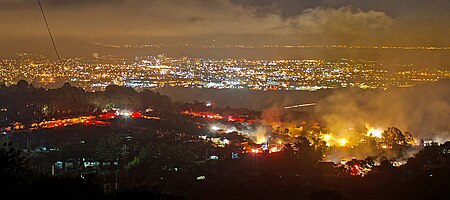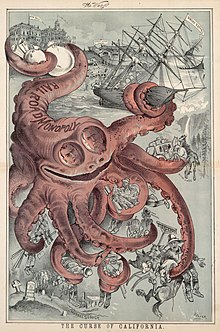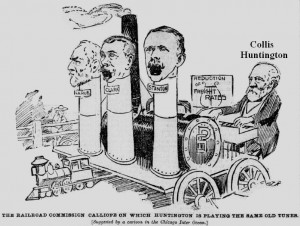On April 22nd, the East Bay Times published a commentary by a representative of the American Enterprise Institute (AEI) calling for the deregulation of the state’s corporations by cutting back on the powers of the California Public Utilities Commission (CPUC). The below comment was submitted but refused with a few minor corrections.
Of course, big business associations like AEI are wanting to make claim that no regulation is the solution to the current nightmare or “CPUCgate” as some are calling the scandals that have rocked the CPUC over the last several years. The core reason the legislature is going ahead with dismantling the CPUC is the serious issue of regulatory capture or to be quite clear the CPUC and its structure has allowed the corporations it regulates to do just about anything they want.
For the past century we have had the same structure in place where governors were given the power to pick the CPUC’s Commissioners. Backed by this argument and with its primary allies’ support (corporations), these picks were almost exclusively from the industry or on occasion major institutions like UC, claiming that oversight required skills that only the industry had.
This was a matter of political power. Between 1900-99 the state elected a Democrat as governor only four times vs. 14 Republicans that held the office for 78 years during the last century! Corporations were more or less content to let a small number of political appointees keep an eye on the CPUC’s independent legal system that consisted of specialized judges trained in a variety of corporate skill-sets to oversee proceedings usually fought out between local communities and corporations (Formal list of CPUC cases between 1914-52). Only during Gov. Jerry Brown’s first term of governor did we see a series of reforms that included the formation of the Division of Ratepayer Advocates that was set up to protect consumer interests. In addition the CPUC was also required to fund independent intervenor groups that made significant input during the quasi legal process, while corporations that are regulated by the CPUC like Pacific Gas & Electric (PG&E) had large legal departments (that the CPUC reimbursed) with the best national resources money could buy.
The system worked fine always making sure that the biggest monopolies like PG&E got a fair rate of return. Intervenor groups on behalf of consumers like TURN expanded at a time when public concern over corporate behavior (greed) grew. In one of the most important decisions the politicized CPUC took on near the end of Jerry Brown’s first and most progressive period was the issue of consumer group’s right to counter corporate claims via the utility’s billing. In the case of PG&E vs. the CPUC, the group TURN (The Utility Reform Network) demanded that it be given the right to submit a rebuttal on the company’s bills that routinely included a newsletter written by the company with its views on CPUC matters. With the state’s mostly conservative media all but censoring the growing disputes between consumer groups, there was little way to get pubic support on their side without such an insert. In a major victory that set off a national movement, the CPUC sided with TURN, ordering PG&E to accept TURN inserts to balance PG&E’s positions. Of course, PG&E took the decision to the US Supreme Court, which on a split decision sided with the company’s claim that the order damaged their free speech rights! And of course the decision was followed by another twenty years of conservative control of the CPUC by Republicans appointments that favored corporate interests on the Commission.
As documented by Ted Nace, in his book the Gangs of America the largest corporations have all but taken over the country due to major legal battles like the above-cited PG&E landmark case that is now used to define free speech today as a matter of who has the most money.
But since the Republican-led electricity deregulation fiasco that ended with the 2001 California Energy Crisis, and given the pressure to act on climate change issues, along with a Democratic political dynasty, the dynamics have changed owing to the immense power wielded by the governor as seen during the 2010 statewide election campaign. Clearly consumers lost as both candidates spent immense sums that will mean even greater pressure for more regulatory capture by special interests. For the CPUC, it meant control of the agency by the former top executive of one of the state’s largest energy company’s – Michael Peevey from Southern California Edison – and CPUC gate scandal involving special treatment of PG&E and So. Cal. Edison which led to the state legislature’s call to breakup the agency following the 2010 San Bruno pipeline disaster.
 As pointed out earlier, California has an extremely conservative past, sprinkled by a number public backlashes such as the upset of the state legislature in1878 by the Working Men’s party which rewrote the state’s constitution establishing the first regulatory body known as the Railroad Commission until it was renamed the CPUC in 1945. The commission was setup as a constitutionally protected regulatory body so that the state’s citizens could gain control over the Central & Southern Pacific railroad empire that controlled of the state’s banks, politicians and much of its land. Actually, the Workingmen didn’t just want to regulate the Octopus, they wanted it to be a public service, owned by public. This was part of the global movement that had gained support across the US and Europe. Note the state had just gone through a severe depression between 1873-79 with unemployment rates on par with the 1934 great depression.
As pointed out earlier, California has an extremely conservative past, sprinkled by a number public backlashes such as the upset of the state legislature in1878 by the Working Men’s party which rewrote the state’s constitution establishing the first regulatory body known as the Railroad Commission until it was renamed the CPUC in 1945. The commission was setup as a constitutionally protected regulatory body so that the state’s citizens could gain control over the Central & Southern Pacific railroad empire that controlled of the state’s banks, politicians and much of its land. Actually, the Workingmen didn’t just want to regulate the Octopus, they wanted it to be a public service, owned by public. This was part of the global movement that had gained support across the US and Europe. Note the state had just gone through a severe depression between 1873-79 with unemployment rates on par with the 1934 great depression.
 The only failure back then was their law banning all corporate lobbying of state politicians (it was made a felony!) with Southern Pacific taking this critical part of the constitution to court and having it tossed out. So whether it was the legislature or the commission doing the regulating Southern Pacific could buy their allegiance. After nearly 30 years of public effort to get rid of the corrupt Railroad Commission it was replaced with a new agency that would oversee far more than just the railroad companies, known today as the CPUC. The true agenda of the CPUC was to replace local control over companies doing business in towns with state control.
The only failure back then was their law banning all corporate lobbying of state politicians (it was made a felony!) with Southern Pacific taking this critical part of the constitution to court and having it tossed out. So whether it was the legislature or the commission doing the regulating Southern Pacific could buy their allegiance. After nearly 30 years of public effort to get rid of the corrupt Railroad Commission it was replaced with a new agency that would oversee far more than just the railroad companies, known today as the CPUC. The true agenda of the CPUC was to replace local control over companies doing business in towns with state control.
This new regulatory plan was promoted by the National Civic Federation (NCF) that was quickly passed into law by nearly every state in the country between 1907-11. The model legislation developed by NCF was produced after investigations of publicly owned utilities in England and the USA by experts selected mostly from private electric companies with an agenda to kill the public ownership movement that was starting to take off in the US, but was far stronger in Europe.
A cool plan which meant that regulated companies no longer had to hire local legal teams to go before your local city board to get permits or set prices. It helped setup the dramatic expansion of what we know today as too big to fail companies that could concentrate their political strategy at the state capital and their legal strategy in San Francisco where the CPUC setup shop originally downstairs from the State Supreme Court – also the headquarters of Southern Pacific and its sister companies PG&E and Pacific Bell.
Did Californians actually get more professional oversight or just the loss of local control? Why did Sacramento for example take over 20 years to break free of PG&E control to form the Sacramento Municipal Utility District (SMUD)? Do you dear citizen know the national history of public vs. private control over utilities and if not why? Hint – follow the money…
The fact is this – you aren’t going to get any serious investigation of these issues on TV, radio or newspapers because nearly are all controlled by the same corporate model – banks and large companies that want your money to come to them first rather than staying local.
Why would working people not want to organize a new way to regulate these too large to fail businesses? Because people are drowning in misinformation and and the concentration of power, not to mention over competition in some of the regulated entities – the very reason this agency was set up a century ago to stop. Small business and residential customers are drowning in high bills – for phone costs that have more than doubled in the last 20 years.
Note the very insidious argument made about natural monopoly vs. competition East Bay editorial (see link at top). This is a false narrative argument. She’s openly lying to mislead you into making what would seem to be a rational choice between the currently failed system to replace it with nothing but an unregulated market. Only with historic perspective and pooled public resources is it even possible to understand what has happened since the entire public battle between public vs. private control of utilities that went on between 1890 to 1940 has been censored out of existence.
The mainstream media are the people that have intentionally censored the entire public vs. private ownership battles over utilities like water, public transit and electricity and telephones, but they were only doing their job. Corporate monopolists like JP Morgan and his allies also saw to it that your school textbooks never mentioned this long history and just how widespread the battles were that spread across the country as well as in Europe.
The battle peaked during the Great Depression that led to the election of Franklin D. Roosevelt who took the necessary steps to get laws that stopped the hidden proxy wars led by the largest Wall Street banks – known as the Glass-Steagal Act that ended Morgan and others from using our money to build giant holding companies hidden within the executive offices of companies like modern day CitiCorp. His reforms included legislation governing electricity companies that killed Morgan’s plan to create an AT&T of electric holding companies known then as the Electric Bond and Share Company.
Was there a reason why FDR won 4 presidential terms? Maybe it was he really cared for the little guy – creating massive works programs, gave us retirement programs – electricity in areas that only the rich could afford, allowed unions the right to organize and shut down the power of Wall Street banks Without the New Deal there wouldn’t be a country here today. And there probably isn’t more than a few people left alive today who were part of it that can defend what he did in an honest manner, unless you want to go even further and suggest we move towards the model that Europe did. But your grandparents really did get what FDR did right away. And that was to get rid Herbert Hoover and conservative’s hands off strategy as evoked by the AEI commentary of deregulation. Instead, we really need to bring back the public vs. private ownership debate for utilities!
Everybody knows that we were promised the best telecom network in the world in 1996 when Clinton and Gore gave away the federal internet infrastructure and set a hands off policy over future development in exchange for the promise that companies would wire the country with high speed fiber optic telecommunication services. That promise was never kept, and DSL services that could have been $15 a month prior to the technology’s capture by the Bell Regional Operating Companies (RBOC). RBOC’s were the companies left over after the breakup of AT&T by consumer activists in 1982. As a result of the massive DSL swindle AT&T was able to rebuild their empire with Pacific Bell being sold to the Texas Bell (SBC) then merged back into AT&T. Clinton ignore consumer groups warning of this danger but he ignored them. Instead of $15 month DSL internet fees costs soared well into the hundreds of dollars a month for simple DSL services, much of the money going into the reformation of the AT&T monopoly.
They have control over the fiber in the ground and refuse to bring out the last phase so you can get better cheaper service while Koreans can get fiber speeds (starting at 50 megs per second) in just about any cafe, leaving most Californians with some of the worst internet services in the world after having put it on the map! Back in the early 1990’s when the internet first took off, the bay area had more internet service providers than the rest of the world did. Today it only has two or three very bad choices all thanks to DSL.
If you go down to the corporate belt in downtown SF twenty years ago, everybody could get 50 megs per second services for 60 bucks a month, but 1 block away in poor man’s land and you had to pay $200 a month for 3 megs a second for DSL access for a small business! The only thing that has changed is that Comcast is offering a price that is still only available to the wealthier segment of the public. What we are witnessing today is of course, captured regulatory bodies messing with the consumer first and foremost.
The big telecoms like AT&T have bled residences and small business to death. And you want to let them deregulate even more? Now why would you get a $300-600 phone for their service contracts? Hey ask these wireless phone companies what it costs to buy 100,000 phones at a time vs. the one you buy?
The overly burdened central telephone exchanges that were originally used to hook us up to the internet were freed by DSL conversion that saved their own land line systems long enough for big telecoms to reassert their national monopoly that could then ignore state regulatory models. We ended up saving their ancient infrastructure long enough so that they could take people into the wireless era then abandon all that copper in the ground. Have you dear Californian for a moment even thought about what this might mean? And especially in quake prone areas? What happens if your wonderfully unregulated cell system collapses in the middle of another major quake? The power goes out and within two days your cell phones don’t have the power to operate, let alone whether many of the state’s cell towers still being intact to deliver a signal. Have your really thought about the trap these people have dug you into? At least the old copper lines had been organized so pay phones were quake resistant and could rely on extremely low amounts of electricity. Go find a pay phone to make call to family on day 3 or 4 of a quake – and you thought the gasoline lines back during the 1970’s was bad…
You trust people in DC to be your friend? I won’t eve trust people in SF or Sacto to be my real friend as a consumer when it means keeping lobbyists from getting into their pants.
Commercial phones cost around $30 a month 25 years ago with prices well below that for the elderly or poor. Yep everybody can afford a basic services these days – let these guys take your cash – all of it goes out of state at a time most service employees can barely afford to cover basic rent and food. Yep lets deregulate them!
The public was promised a world class telecom system. What we got was a disaster.
Every time we’ve privatized utilities, we’ve handed policy over to giant companies that have done everything in their power to protect their own interests not the publics. Whether its a thousand channels of nothing or hearing about how Arizona is trying to pass a constitutional amendment to keep their electric companies from trying to kill the development of wind and solar power, or the insane PR ads we are being bombarded hourly by PG&E we are paying for their greed at a time when many have yet to recover from the 2008 downturn.
Maybe its time to wake up and change this consumer nightmare.
